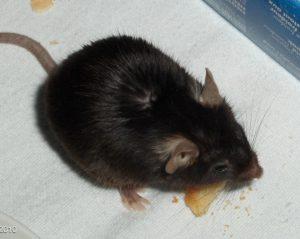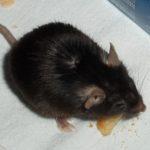
Lab mouse of strain C57BL/6, female, 22 months of age, while eating a crumb of cake. Au: Alex Weingarten, Wikimedia Commons
CD45.1 and CD45.2 C57BL/6 (B6) mice strains often used for in vivo tracking of immune cell development, were previously thought to differ by only five amino acids in the CD45 molecule. Genotypic analysis of these two strains has identified differences in 43mbp encoding for over 300 genes, suggesting that there could be underlying differences in immune responses by these otherwise identical mice.
Researchers observed differential murine survival of CD45.1 and CD45.2 B6 mice infected with murine cytomegalovirus (MCMV), influenza A and Citrobacter rodentium. Where in CD45.1 and CD45.2 were more equipped to fight lethal doses of MCMV and influenza virus, respectively, while both mouse strains were equally resistant to C.rodentium infection.
Detailed analysis of CD45.1 and CD45.2 strains, enabled researchers to identify a key difference in expression of natural cytotoxicity receptor 1 (NCR1) on NK cells between the two strains, where CD45.1 mouse strains did not express NCR1. Interestingly, Ncr1 transcript levels were similar between both mice strains, suggesting that translation or post-translation defects may be responsible for differential expression between these two otherwise identical mice. Loss in expression of NCR in CD45.1 mice was attributed to a point mutation in the start codon of Ncr1 transcripts, which results in the abrogation of Ncr1 mRNA translation to protein and no expression of NCR1 by NK cells.
Researchers observed that introduction of the Ncr1 point mutation in CD45.1 B6 strains led to increased IFN-γ responses at the site of infection and resistance to MCMV infection compared to wild type (CD45.2 B6). This in part was attributed to loss in downstream of kinase (Dok)-1 activation in NK cells that lacked NCR1. Studies have shown that over-expression of Dok-1 in NK cells resulted in reduced IFN-γ production. This suggests a potential regulatory role of NCR1 on Dok-1 activation, which requires further studies to elucidate this.
This research highlights a potential confounder in experimental interpretation of tracking lymphocyte development using CD45.1 mice strains, under the assumption that the only difference between these mice and CD45.2 B6 strain is the CD45 isoform.
Journal Article: Jang et al., 2018. Cutting Edge: Check Your Mice−−A Point Mutation in the Ncr1 Locus Identified in CD45.1 Congenic Mice with Consequences in Mouse Susceptibility to Infection. Journal of Immunology.
Journal Article by Cheleka AM Mpande
